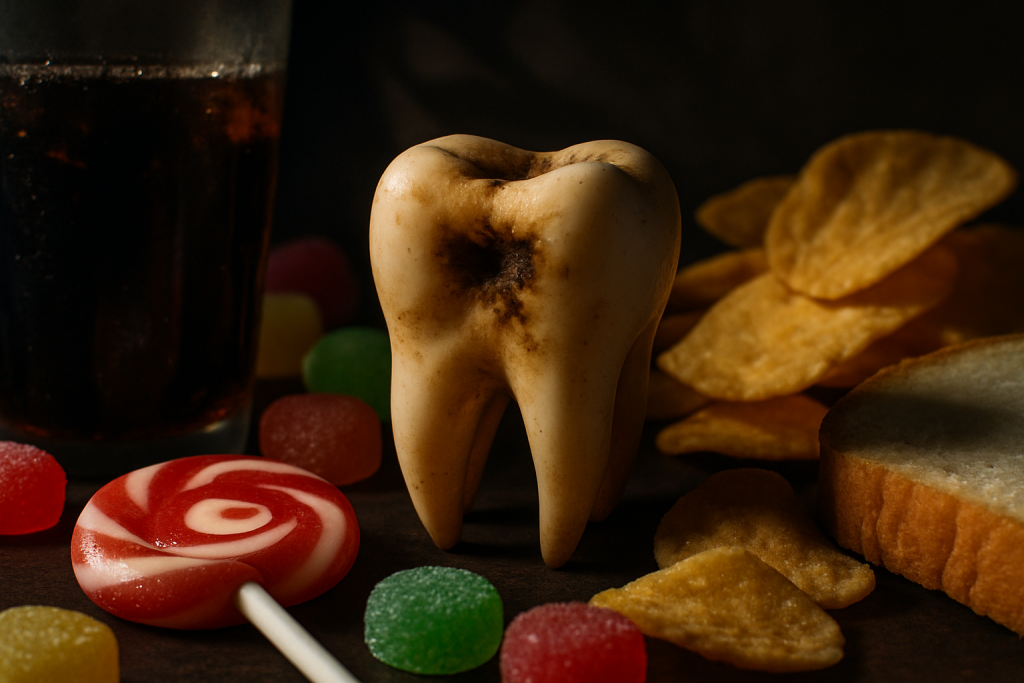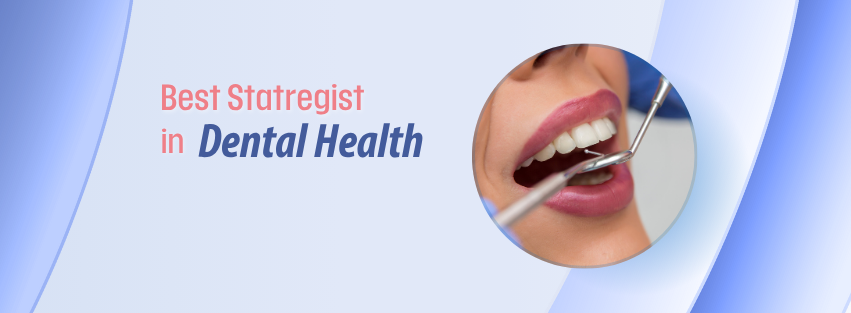
Tooth decay is a common dental issue that can affect anyone, but some groups are more susceptible than others. Understanding who is most likely to get tooth decay can help you take preventive measures to protect your dental health. Let’s look at various factors that increase the risk of tooth decay.
Age factors:
Children and older adults are particularly prone to tooth decay. Young children often consume sugary foods and drinks, and their brushing habits may not be fully developed. This can lead to cavities forming in their primary teeth. In contrast, older adults might face decay due to worn-down enamel or gum recession, exposing their tooth roots.
Dietary habits:
Your diet plays a significant role in your risk of tooth decay. Here are some dietary choices that can increase the likelihood of cavities:
- High Sugar Intake: Foods and drinks that are rich in sugar provide fuel for the bacteria in your mouth. These bacteria produce acids that erode tooth enamel.
- Acidic Foods and Drinks: Citrus fruits, soda, and other acidic items can weaken enamel, making teeth more vulnerable to decay.
- Frequent Snacking: Constantly nibbling on snacks, especially sugary ones, gives bacteria a continuous supply of sugar.
Oral hygiene practices:
Your daily oral care routine significantly impacts your risk of tooth decay. Individuals who neglect brushing and flossing regularly are more likely to develop cavities. Brushing twice a day with fluoride toothpaste helps strengthen enamel and reduces plaque buildup. Flossing daily removes food particles and plaque from between your teeth.
Fluoride exposure:
Fluoride is essential in preventing tooth decay. It helps repair enamel and makes teeth more resistant to acids. People who do not get enough fluoride are at a higher risk for decay. This is especially crucial for children, as fluoride can be found in community water supplies and certain dental products.
Medical conditions:
Certain health conditions can also increase your risk of tooth decay. For example, people with dry mouth, often caused by medication or specific medical conditions, have less saliva to wash away food particles and neutralize acids. Additionally, diabetes can lead to increased sugar levels in saliva, fostering a more inviting environment for bacteria.
Socioeconomic factors:
Socioeconomic status can play a considerable role in oral health. Individuals with lower incomes might not have access to regular dental care, leading to untreated cavities. Additionally, people from lower socioeconomic backgrounds might have less knowledge about proper oral hygiene practices, further increasing their risk.
Genetic predisposition:
Your genes can influence your susceptibility to tooth decay. Some individuals may inherit traits that make their enamel weaker or lead to a more acidic mouth environment. If tooth decay runs in your family, you may need to be extra vigilant about your dental health.
Gender differences:
Research indicates that men may be more likely to develop tooth decay than women. While the specific reasons for this difference aren’t entirely clear, it could be linked to lifestyle choices and differing health habits between genders.
Ultimately, being aware of who is most at risk for tooth decay is essential for taking preventive action. Regular dental check-ups, a balanced diet, and good oral hygiene can make a significant difference. Remember, you have the power to protect your teeth by making informed choices and prioritizing your dental health.
Being proactive is the best strategy. Whether you’re a parent teaching your child about brushing teeth or an adult seeking healthy habits, always aim for a routine that keeps your teeth strong and cavity-free. Awareness and action are your best defenses against tooth decay.
The role of diet in tooth decay susceptibility:
Understanding how diet influences tooth decay susceptibility can help you make better choices for your oral health. Tooth decay occurs when the enamel of your teeth becomes damaged, often as a result of bacteria feeding on sugars from the food you eat.
Knowing which foods to enjoy and which ones to limit can be vital in preventing tooth decay.
Your diet plays a significant role in the health of your teeth. Foods high in sugar, for example, can lead to the growth of harmful bacteria. These bacteria produce acids that can erode tooth enamel, a process that may eventually lead to cavities. Here are some dietary factors that can make you more prone to tooth decay:
High sugar consumption:
One of the biggest culprits in tooth decay is sugar. When you consume sugary foods, the bacteria in your mouth feed on these sugars, producing acids as waste. Regularly indulging in sugary snacks can lead to a continual battle against tooth decay. Foods like:
- Candy
- Soft drinks
- Cakes and pastries
- Ice cream
These items can contribute significantly to the risk of cavities, especially if they are consumed frequently. It’s essential to limit these foods and choose healthier alternatives.
Acidic foods and beverages:
Besides sugar, acidic foods can wear away tooth enamel. Foods or drinks that are high in acidity can lead to what is known as acid erosion. Items such as:
- Soft drinks
- Citrus fruits, like oranges and lemons
- Vinegar-based dressings
These can contribute to a higher risk of developing tooth decay if consumed excessively. If you enjoy these items, consider balancing them with less acidic foods to maintain a healthy mouth.
Starchy foods:
While they may not seem harmful, starchy foods like bread, chips, and pasta can also contribute to tooth decay. When these starchy foods break down, they convert to sugars which can feed the bacteria in your mouth. This can lead to acid production and potential decay.
The importance of nutrients:
On the flip side, certain nutrients can actually help in the fight against tooth decay. Calcium, phosphorus, and vitamin D are essential for maintaining strong teeth and bones.
- Calcium can be found in dairy products like milk, cheese, and yogurt.
- Phosphorus is available in food items like fish, poultry, and nuts, all of which support overall dental health.
- Vitamin D, which can be obtained from sunlight and certain foods, helps the body absorb calcium effectively.
Hydration matters:
Drinking water is crucial for oral health. Water helps wash away food particles and bacteria from your mouth. It also prevents dry mouth, a condition that can increase your risk for tooth decay. Try to choose water over sugary drinks to keep your mouth hydrated and balanced.
Timing of snacks and meals:
The timing of your meals also matters. Frequent snacking can expose your teeth to sugars and acids throughout the day. Instead, aim for three balanced meals a day, and try to limit snacks to healthy options like fruits, vegetables, or cheese.
Choosing the right foods and maintaining a balanced diet is essential in reducing the risk of tooth decay. By paying attention to what you eat and when you eat, you can protect your teeth from the harmful effects of sugar and acidity.
Consider introducing foods rich in nutrients to support your oral health and remember to stay hydrated with water.
How genetics influence dental health and decay risk?
Genetics play a significant role in determining your dental health and the risk of tooth decay. If you’re wondering how inherited traits can impact your teeth, you’re not alone. Understanding this connection can help you make better choices for your oral care.
To start, it’s essential to know that certain genetic factors influence how strong your teeth are.
Some people are born with enamel that is naturally thicker and more resilient. This strong enamel can provide better protection against cavities and decay. On the other hand, if you have thinner enamel due to your genes, your teeth might be more vulnerable to the effects of sugary foods and drinks.
Another genetic aspect to consider is your saliva composition. Saliva helps wash away food particles and neutralizes acids produced by bacteria in your mouth. If you have a genetic predisposition to produce lower amounts of saliva, you may find yourself at a greater risk for tooth decay.
This is because less saliva means that food debris can linger longer on your teeth, leading to a higher chance of cavities.
Many people also inherit certain oral bacteria from their parents. These bacteria can vary in their ability to cause decay. Some strains are more harmful than others, contributing to a higher risk of tooth decay.
If your family has a history of dental issues, it might be wise to be particularly proactive about your oral health.
Here’s a list of genetics-related factors that can impact your risk of developing tooth decay:
- Enamel Thickness: Thicker enamel provides better protection against decay.
- Saliva Production: Less saliva can increase the risk of cavity development.
- Bacterial Composition: Some inherited bacteria are more harmful to teeth than others.
- Dietary Preferences: Genetic predispositions can influence your taste for sugary or acidic foods.
- Immune Response: A strong immune system can better fight off infections that might affect dental health.
Your diet also plays a crucial role in how your genetics impact your dental health. Certain genetic traits can affect your taste preferences, which may lead you to favor sugary foods or drinks.
If your genetics make you more likely to crave sweets, it becomes even more important to care for your teeth adequately. Regular brushing and flossing, along with a balanced diet, can help mitigate the risk.
Another factor linked to genetics and dental health is the alignment of your teeth. Some people inherit jaw shapes that lead to overcrowding or gaps between their teeth. Misaligned teeth can trap food particles, making it harder to clean your mouth effectively. If your teeth don’t fit together correctly, they may also wear down unevenly, increasing your chances of decay and gum disease.
While genetics plays a significant role, your lifestyle choices also matter greatly. Maintaining good oral hygiene habits is crucial. Brushing your teeth at least twice daily, flossing regularly, and visiting the dentist for check-ups can help manage the risks associated with genetic predispositions. While you may not be able to change your genetics, you can control how you respond to these factors.
Genetics do play a crucial role in determining your dental health and tooth decay risks. Understanding how these hereditary traits affect your oral health can empower you to make better choices. Focus on maintaining a healthy lifestyle and keeping up with your dental care to keep your smile as bright and robust as possible.
The impact of oral hygiene practices on tooth decay likelihood:

Maintaining good oral hygiene is crucial for preventing tooth decay, a common dental issue that can affect anyone. To understand the impact of oral hygiene practices on the likelihood of developing tooth decay, we need to look at several key factors that contribute to oral health.
First, regular brushing is essential. Dentists recommend brushing at least twice a day to remove plaque and food particles. Plaque is a sticky film of bacteria that forms on your teeth, and if not removed, it can harden into tartar, leading to tooth decay. Make sure to use fluoride toothpaste, as fluoride helps strengthen tooth enamel, making it more resistant to decay.
Flossing is another vital practice in your dental care routine. Many people overlook flossing, but it plays a significant role in preventing cavities between teeth, where toothbrushes often can’t reach. By flossing daily, you remove food debris and plaque from these tight spaces, greatly reducing your chances of developing cavities.
Saliva also plays a significant role in oral health. It helps wash away bacteria and food particles, neutralizing acids produced in the mouth. Staying hydrated is key, as dehydration can reduce saliva production, increasing your risk of decay. Chewing sugar-free gum after meals can also stimulate saliva flow, further protecting your teeth.
Smoking and tobacco use can harm your oral health and increase the risk of tooth decay. Tobacco products can lead to dry mouth, which reduces saliva flow. Additionally, they can cause gum disease, which may contribute to tooth loss. Quitting smoking can significantly improve your overall oral health.
Age is another factor influencing the likelihood of tooth decay. Children are particularly vulnerable to cavities because they may not have fully developed brushing habits.
Similarly, older adults may face an increased risk due to factors such as dry mouth, receding gums, or medications that affect oral health. Both age groups can benefit from tailored oral hygiene practices, such as using fluoride treatments or specialized dental products.
The impact of oral hygiene practices on the likelihood of tooth decay is significant. By brushing and flossing daily, watching your diet, staying hydrated, and maintaining regular dental appointments, you can greatly reduce your chances of developing cavities. Remember, good oral hygiene isn’t just about achieving a bright smile; it’s a key part of your overall health. Focus on these practices, and you’ll be on your way to a healthier mouth and a lower risk of tooth decay.
Conclusions:
Understanding who is most likely to get tooth decay is essential for both individuals and healthcare providers. Various factors contribute to one’s risk, with diet playing a significant role. Frequent consumption of sugary and acidic foods can fuel the decay process, making it crucial to maintain a balanced diet rich in nutrients that promote oral health.
Genetics also hold sway over dental health, influencing everything from tooth structure to saliva production. Some people might have inherited traits that make them more susceptible to cavities, highlighting the importance of personalized dental care. Regular check-ups can help identify such risks early on.
